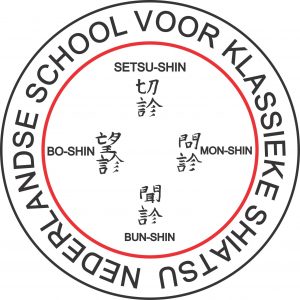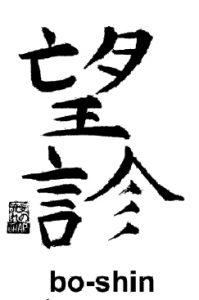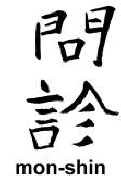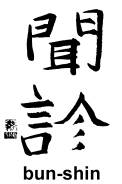
There are four routes that lead to effective Shiatsu treatment. These merge with each other, feed and support each other. Do not underestimate the power of these four shins. These four ways lead to making the right diagnoses, and at the same time have an effect on the recipient. Diagnosis and healing go hand in hand.
Walking these four paths helps you to get to know yourself better and to understand the other better. And for those who have an attentive eye, the following may have already been noticed: Each of these four ways has a well-deserved place in the logo of the NSKS.
 Bo-shin, the art of observation
Bo-shin, the art of observation
The art of receiving visual observations (for example facial expression, posture or the way someone moves) enabling a correct interpretation of someone's condition and vitality.
 Mon-shin, the art of communication
Mon-shin, the art of communication
Mon-shin is the art of interpreting, souplesse and presence of conversational and contactual characteristics (e.g. talk lightly about serious matters, touching certain body parts and particular facial expressions whilst talking about specific subjects), enabling a correct interpretation of someone's condition and vitality.
 Bun-shin, the art of listening
Bun-shin, the art of listening
The art of receiving perceptions through sound (for example sound of voice) ) enabling a correct interpretation of someone's condition and vitality. These have the healing properties to remove a blockade.
 Setsu-shin, the art of touching
Setsu-shin, the art of touching
The art, reception and performance of subtle touch. This touch can be carried out with both hands and other parts of the body (e.g. feet, knees, fingers and thumbs).
Touching is listening and communicating with your hands. You will be introduced to the eight principles (see below). You will learn more about the other person in this way. Is there a blockade somewhere and what do I do about it?
The eight principle patterns
The NSKS focuses on Hara diagnosis supported by confirmation of back diagnosis, but the eight principles can be experienced anywhere in the body.
The Hara is the soft part between your ribcage and your pubic bones. All organs (and therefore meridians) are represented in this area. A correct interpretation of this area leads to a correct Shiatsu diagnosis. And just as the introduction above indicated: diagnosing via the Hara is often already a treatment.
All organs are also represented on the back (and ears, and feet, and hands, and wrist, etc.). To find out if you have correctly interpreted the Hara, you can gain support from the back-diagnosis.
Recognition of physiological appearances in relation to the eight principle patterns:
YANG and YIN
HOT and COLD
EXTERIOR (HYO) and INTERIOR (RI)
FULL (JITSU) and EMPTY (KYO)
